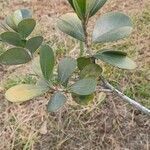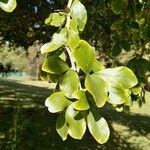Tree or shrub, 1.8-7.6 m high, evergreen, dioecious, rarely polygamous, armed with spines. Leaves fascicled, young shoots alternate, petiolate; obovate or elliptic-rhomboid, blade soft to coriaceous, 3-5-veined from base, margins entire. Male flowers in fascicles of 5-10 flowers in groups of 3, pedicellate; calyx 2-5-lobed; corolla absent; stamens many. Female flowers solitary or in fascicles of 2 or 3, pedicellate; calyx 5-7-lobed, lobes elliptic-lanceolate; corolla absent; styles 5-7; ovary unilocular; placentas 5-7, each with 2 ovules. Flowering time Sept.-Mar. Fruit a subglobose berry, minutely hairy, bright yellow.
A spiny shrub. It grows up to 6-9 m tall. It has long straight spines on the trunk and branches. They are about 3 cm long. The bark is white when young. The leaves are simple and carried one after another along the stem. The edges of the leaves roll back slightly. The leaves are dark green and glossy. Plants are separately male and female. The female flowers are 3 mm long and light green. They occur as 1-3 together in the axils of leaves. The male flowers are in dense short clusters in the axils of leaves. The fruit are medium sized and yellow. They are round and 2.5-4 cm across. The skin is tough. The fruit are edible.
Male flowers densely fascicled in the axils or commonly on abbreviated side-shoots; pedicels 1–3 mm. long, puberulous; calyx with 5 lobes divided almost to the base, lobes c. 2.5 x 1.5 mm., narrowly ovate, apex acute, shortly pubescent on both sides; stamens c. 15; filaments c.5 mm. long; inter-staminal glands very minutely pubescent, at least at their apices.
Leaves often fasciculate on short side-branches; lamina 2–5.5 x 0.5–2.7 cm., narrowly obovate, obovate or obovate-elliptic, apex rounded or retuse, cuneate or narrowly rounded and 3-nerved at the base, margins entire, slightly revolute, venation slightly raised on both sides and very laxly reticulate; petiole up to 5 mm. long.
Female flowers solitary on pedicels up to 8 mm. long; calyx lobes 5–8, slightly larger and wider than the males; annular disk undulately lobed, rather thick, minutely and sparsely puberulous or glabrous; ovary globose-ovoid, glabrous, with 5–8 divergent, puberulous styles c. 2.5 mm. long; stigmas somewhat spreading.
Native of southern Africa, from Rhodesia to the Cape Province, is commonly cultivated in the highlands of East Africa, principally as a hedge plant but also for its edible fruits,
Shrub up to about 3.5 m. tall, glabrous in all its vegetative parts; branches smooth, grey and armed with stout spines up to about 6 cm. long.
Fruit fleshy, apricot-coloured, up to 4 cm. in diam., globose, glabrous, crowned with the persistent styles.
Seeds c. 12, woolly.



